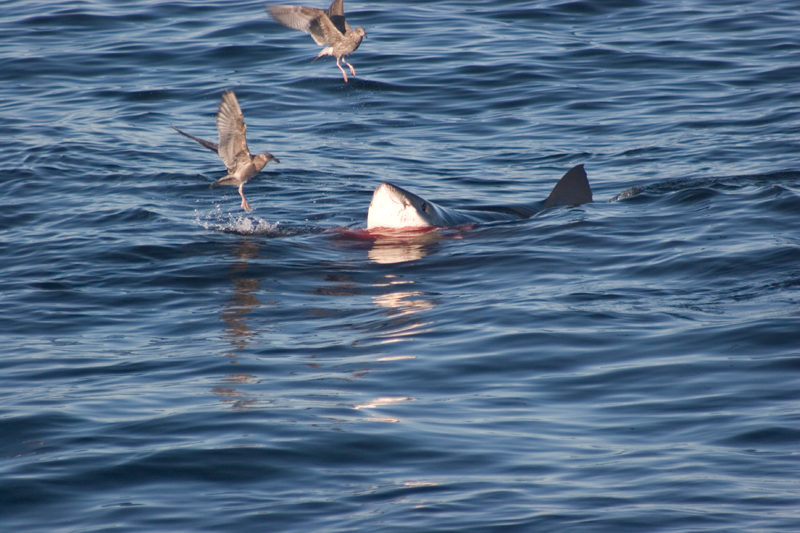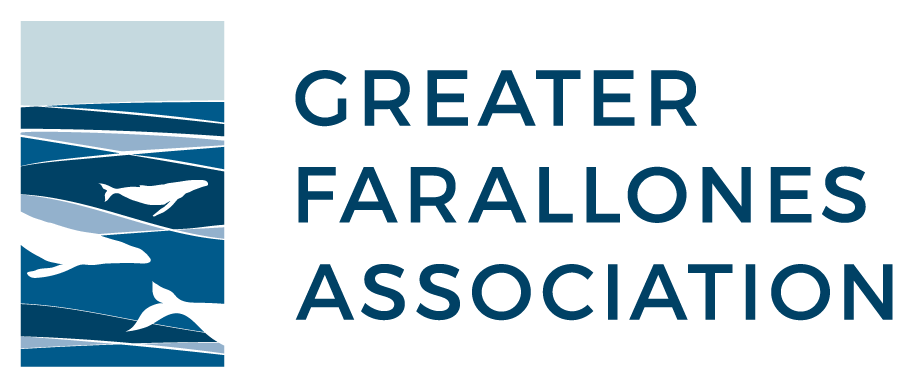Getting Curious About White Sharks with Farallones Naturalist Pete Winch

Greater Farallones National Marine Sanctuary is home to one of the most significant populations of white sharks on the planet. Although they can be spotted year-round, white sharks are primarily seasonal visitors to the sanctuary, returning each fall. To celebrate their return this year, we chatted with our staff Naturalist and Education Specialist Pete Winch about why the sanctuary is such a hotspot for white sharks, where they are returning from, and much more.
Read the Q&A below.
Pete, why do white sharks return to the sanctuary in the fall?
“The white shark population returns to the sanctuary to eat pinnipeds, specifically young elephant seals. The Farallon Islands, in particular, are home to a large seasonal population of about 250 elephant seals which find refuge on the islands from fall to early spring. Elephant seal pups born in the winter leave the islands in March and head to Northern Pacific waters to fatten up on squid and fish. In September, the 7-8 month old seals return to the island. These young and naive seal pups are a target for the returning white sharks because they are easier to catch and because they have a very high fat content. The calories in this fat are extremely important for apex predators such as white sharks.
Older elephant seals are also eaten, but there is a slant towards the younger ones. Elephant seals make up 65 % of the white shark diet at the Farallones! The remaining 35% of their diet consists of the other four species of pinnipeds that live on the islands: harbor seals, California sea lions, Steller sea lions, and northern fur seals.”
Where are they coming from?
“Biologists have tagged white sharks at the islands to track their movements. A large percent of the tagged sharks spend time at an area nicknamed ‘The White Shark Cafe.’ This area is located in a deep water part of the Central Pacific Ocean, roughly between Baja and Hawaii. Research here is at its early stages, and nothing is confirmed, but it has been suggested that this could be a mating site for white sharks.
Tagging has revealed the females in this area swim at a constant depth of around 100ft, but the males’ swim pattern involves going up and down from shallow to deeper water several times a day. While this ‘cafe’ is where a large majority of the tagged Farallon Islands sharks end up, some have been recorded to travel as far as Hawaii.”
Is it common to actually see white sharks? If so, what should folks hoping to get a glimpse of one from land or boat look out for?
“It’s not common to see white sharks at the Farallon Islands, mainly because they are fish and are rarely near the surface. They need to swim under their prey as they will often hunt by swimming fast upwards to surprise the young pinnipeds, so this minimizes their time at the surface.
Also, the iconic imagery of the ‘Jaws’ dorsal fin emerging from the surface is somewhat of a fallacy, as that dorsal fin has an important role in stabilizing the movement of white sharks. If it is above the water, that stability is lost.
You do get rare sightings of white sharks at the Farallones. A predation event on a pinniped might mean you see the shark for 10 to 20 minutes as they consume the pinniped’s carcass. Very rarely, visitors to the Farallones might see a white shark come completely out of the water performing breaching behavior.”
Have you ever seen a white shark? What was the experience like?
“I have been lucky enough to see a few white shark predations at the Farallon Islands. One is often first alerted to a predation by a flurry of western gulls just over the water. The gulls see the predation and fly over hoping for scraps of pinniped flesh.
Next there is usually a red blood stain on the water. Sometimes, you can even smell the blood. You can almost taste the iron in the air. Then, if the carcass floats you may get to see the shark. The tail fin is longer than the dorsal fin so both are visible protruding above the surface of the water.
Again, with a floating carcass you may get to see the white shark take bites out of the pinniped. There is sometimes a lot of thrashing and splashing as the shark uses its tail and body to help wrench chunks of flesh from the carcass.
I have seen one breach. It lasted a second, and my main memory was how white the underside of the shark was as it had its belly towards the boat. It was also great to see the length of the shark’s pectoral fins – which looked like little white wings.”
Favorite fact about white sharks?
“No one has seen a white shark mate or give birth. These gaps in our knowledge are quite inspiring for young scientists. They could be the ones who discover these missing pieces of information if they aspire to become marine scientists!”
Learn more about how Greater Farallones National Marine Sanctuary helps to protect white sharks.

